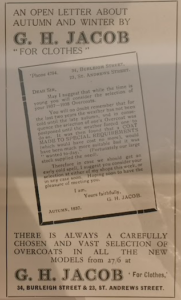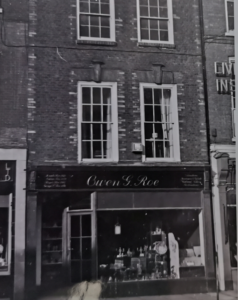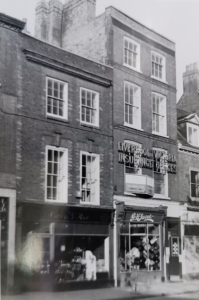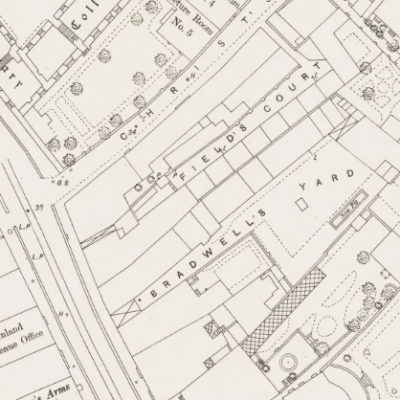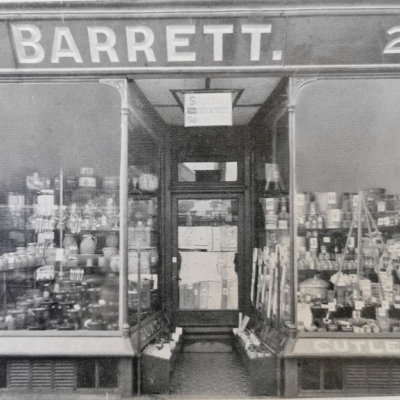Search by topic
- archaeology
- architecture
- bricklayer
- Building of Local Interest
- carpenter
- church
- crime
- dressmaker
- fire
- general labourer
- Great Eastern Railway
- listed building
- medieval
- oral history
- Public House
- Rattee & Kett
- Roman
- scholar
- school
- Then and Now
- tudor
- women
- work
- world war one
- world war two
Search by text
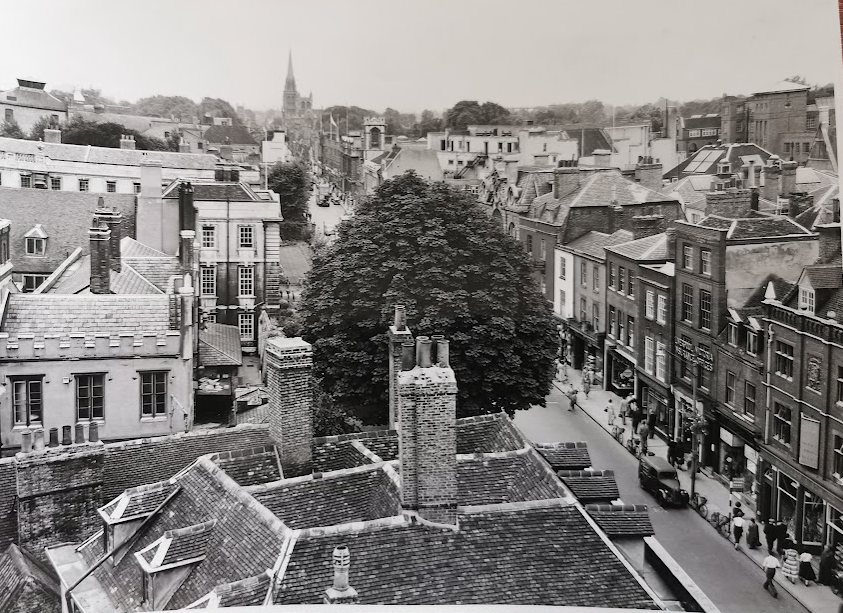 St Andrew's Street (MoC294/54) Liverpool Victoria bottom right
St Andrew's Street (MoC294/54) Liverpool Victoria bottom right23 – 24 St Andrew’s Street
History of 23 - 24 St Andrew's Street
The Grand Arcade excavation uncovered a C13th well, Well 32, which would have served Plot XV which corresponds to this address. The well was in use for about a century. A description and analysis of the finds from the well can be found on page 113 of the report published in 2019.
Building 20, at the west end of Plot XVI, was one of the most intriguing structures found during the excavation. It is believed to have been malting kiln. (p145-146) dating from the mid-C15 to mid-C16.
Well 42 was also on this plot. It was constructed in the 1620s. Arches from church lancet windows of c.1250 were reused to make the lining of the well. This material would almost certainly have become available after the Dissolution; it could have come from within the city but it is also known that stone from religious houses in the Fens was transported to Cambridge. (p228)
The finds made on this site dating from the 19th century are discussed on page281f of the Grand Arcade report. The backfilling of Soakaway 3 on the site is important.
The backfilling of Soakaway 3 dates to c. 1808–25 and the assemblage of over 300 items (MNI) consisting of pottery and glass vessels, clay tobacco pipes and bone is a mixture of domestic and business material, dominated by items related to dining. Some of this material predates the end of Thomas Wicks’ apprenticeship c. 1795 and occasionally even his birth in 1774. Examples of this include four Chinese export porcelain vessels (c. 1730–50 and 1750–60), two Staffordshire white salt-glazed stoneware vessels (c. 1750–65), two glass utility bottles (c. 1750–80), a bottle seal of 1770 and a piece of English soft paste porcelain (c. 1760–70). This pattern suggests that some of the material comprised in some sense either familial or business ‘heirlooms’.
According to 1959 Royal Commission on Historical Monuments Survey of Cambridge, no. 24 is of three storeys. It was built early in the 18th century.
1841 unnumbered
(23?)
Thomas Wicks, 65, cook
Rose, 60
Jane Booth, 20, servant
Mary Savill, 20. servant
(24?)
This plot was probably occupied by the Burbage family from the late eighteenth century onwards. Charles Burbage , butler of Emmanuel College between 1828 and 1847, lived here from 1841 to 1847, followed by his mother Anne (1847-8) and his nephew James Burbage (1848-9) who was also the College butler. (Grand Arcade report 2019)
1851
(23?) Unnumbered
Thomas Wicks, 76, cook Emmanuel College, b Cambridge
Rose, 73, b Horningsea
Charlotte Townsend, 30, servant, b Little Shelford
Sarah Day, 31, b Stansford
(24?) Unnumbered
James William Pryor, 28, solicitor, b Cambridge
Sarah Freeman, 53, b Hunts
Sarah Beeter, 20, housemaid, b Madingley
1861
(23)
Joseph Wentworth, 33, auctioneer and appraiser, b Cambridge
Ellen Grace, 25, b London
Constance, 3, b Cambridge
Ada Augusta, 8m, b Cambridge
Rebecca Ambrose, 24, cook, b Willingham
Harriett Stapleton, 20, nursemaid, b Norfolk
Ellen Miller, housemaid, b Arrington
(24)
Isaac Weaver, 68, fruiterer, b Somerset
Maria, 63, b Norwich
Susan, 26, b Cambridge
Henry Day French, 19, lodger, undergraduate, b Norfolk
Herbert S Francis, 23, lodger, graduate, b Lambeth
1871
(23)
James Beck, 42, general practitioner, b Bombay India
Elizabeth, 34, b Beds
James W, 5, b Cambridge
Edith, 1, b Cambridge
Elizabeth Gunton, visitor, 34, b Cambs
G A Gunton, 12, b Cambs
Agnes E Gunton, 9, b Cambs
Harriett Bedford, 18, servant, b Hunts
Mary Ashbury, 20, b Chesterton
(24)
Eliza Gosnold, 66, widow of Lieut James Gosnold R.N., b Melbourn
Mary A, 27, b Melbourn
Charles S Weir, lodger, 51, barrister, b Middlesex
1881
(23)
Askew Wilson, 36, sergeant at mace, b Trumpington
Mary A, 28, b Girton
Charles W, 4, b Cambridge
Ellen C, 11m, b Cambridge
(24)
Robert Ayres, 40, painter, b Liverpool
Mary A, 40, b Meldreth
Charles E Boyer, lodger, 21, gentleman, b Yorks
1891
(23)
Hedley Burgess, 29, printseller, b Bucks
Tabitha, mother, 50, b Bucks
Emily Tucker, 15, servant, b Cambridge
(24)
William J Hall, 30, waiter, b Cambridge
Caroline, 27, b Cambridge
Ethel May, 6, b Cambridge
Rita V, 3, b Cambridge
Sydney, 2, b Cambridge
Kate Cooper, 13, servant, b Longstanton
1901
(23)
Marion Ingle, 87, b Cambridge
Marian, 47, milliner, b Cambridge
Kezia, 43, b Cambridge
Amy Humphrey, 37, b London
(24)
William James Hall, 40, butler, b Cambridge
Clara Ellen M, 27, b Chesterton
Ethel May, 17, b Cambridge
Rita Lilian H, 13, b Cambridge
Sydney William, 17, b Cambridge
George C F, 4, b Cambridge
Charles Harold W, 1, b Cambridge
1911
(23)
James William Pearl, 48, engineer fireman, b Castle Camps
Suzannah, 48, b Hunts
Florence Elizabeth, 24, dress maker, b Cambridge
(24)
Jesse Lewis, 28, paperhanger and painter, b Cambridge
Lizzie Mabel, 26, b Coton
Reginald, 4, b New Cherry Hinton
1913
(23)
Scotch Wool and Hosiery Store
A A Walker, solicitor
(24)
Coulson and Co, theatrical costumiers
Arthur Wright, solicitor, deputy coroner
1937
1962
(23)
G H Jacob & Son, outfitters
Liverpool Victoria Friendly Society
(23-25)
Careers Research and Advisory Centre
(24)
Coal Utilisation Council
1970
Coal Utilisation Council (information centre)
Contribute
Do you have any information about the people or places in this article? If so, then please let us know using the Contact page or by emailing capturingcambridge@
License
 This work is licensed under a Creative Commons Attribution-NonCommercial-ShareAlike 4.0 International License.
This work is licensed under a Creative Commons Attribution-NonCommercial-ShareAlike 4.0 International License.








